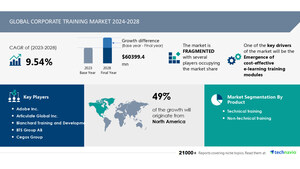NEW YORK, June 3, 2024 /PRNewswire/ -- The global haptics market size is estimated to grow by USD 9.67 billion from 2024-2028, according to Technavio. The market is estimated to grow at a CAGR of 12.88% during the forecast period.
For comprehensive forecast and historic data on regions, market segments, customer landscape, and companies- Click for the snapshot of this report
Haptics Market Scope |
|
Report Coverage |
Details |
Base year |
2023 |
Historic period |
2018 - 2022 |
Forecast period |
2024-2028 |
Growth momentum & CAGR |
Accelerate at a CAGR of 12.88% |
Market growth 2024-2028 |
USD 9674.9 million |
Market structure |
Fragmented |
YoY growth 2022-2023 (%) |
11.16 |
Regional analysis |
APAC, North America, Europe, South America, and Middle East and Africa |
Performing market contribution |
APAC at 71% |
Key countries |
China, Japan, US, South Korea, and India |
Key companies profiled |
3D Systems Corp., AAC Technologies Holdings Ltd., Alps Alpine Co. Ltd., Analog Devices Inc., Flaim Systems Pty Ltd, Force Dimension, HAPTION SA, HaptX Inc, Immersion, Infineon Technologies AG, Johnson Electric Holdings Ltd., Microchip Technology Inc., ON Semiconductor Corp., OSRAM Licht AG, Precision Microdrives Ltd., SMK Corp., Synaptics Inc., Texas Instruments Inc., Toyoda Gosei Co. Ltd., and Ultraleap Ltd. |
Market Driver
The haptics market is experiencing significant growth due to advancements in smart material actuator technologies. These include electrostatic, dielectric EAP, EMP, and piezo ceramic. Electrostatic technology enables localized haptic feedback, while dielectric EAP and piezoceramic actuators are ultrathin and easy to integrate. EMP material, with its high elastic modulus and low strain, is ideal for developing ultrathin and ultralight actuators.
These technologies are driving the market, particularly in the consumer electronics sector, where localized haptic feedback is essential for multi-touch devices. The automotive industry is also expected to adopt these technologies for enhanced user experience.
The haptics market is experiencing significant growth with increasing adoption in various industries. Consoles, immersive experiences, and wearable technology are key areas driving market expansion. Actuators and controllers are crucial components in haptic technology. Devices such as tablets and smartphones are integrating haptic feedback to enhance user experience.
Haptics in vehicles is also gaining traction, making driving more realistic. Haptic gloves and suits are popular in gaming and training applications. Defenses and defense industries are utilizing haptics for tactile interfaces. The future of haptics lies in advanced technologies like piezoelectric and tactile sensors. Haptics in wearables and virtual reality is expected to be a major trend.
Market Challenges
- The haptics market faces a significant challenge with power consumption, particularly in battery-critical mobile applications. Basic haptics, such as vibration alerts, have minimal impact on battery life. However, high-definition haptics technologies, which require multiple actuators, amplifiers, and sensors, result in substantial power consumption. This high power consumption may hinder the growth of the global haptics market during the forecast period.
- The haptics market is experiencing significant growth, with consumers and businesses increasingly relying on tactile feedback in various applications. However, several challenges persist in this industry. One major challenge is the development of cost-effective haptic solutions that can provide accurate and realistic feedback.
- Another challenge is the integration of haptics into wearable and mobile devices, requiring miniaturization and power efficiency. Additionally, creating haptic experiences that are customizable and adaptable to different users and environments is a complex task.
- Furthermore, ensuring the durability and reliability of haptic components is essential to maintain user satisfaction and trust. Overall, addressing these challenges will be crucial for the continued growth and success of the haptics market.
Research report provides comprehensive data on impact of trend, driver and challenges - Request a sample report!
Segment Overview
- Application
- 1.1 Consumer electronics
- 1.2 Automotive and transportation
- 1.3 Others
- Component
- 2.1 Hardware
- 2.2 Software
- Geography
- 3.1 APAC
- 3.2 North America
- 3.3 Europe
- 3.4 South America
- 3.5 Middle East and Africa
1.1 Consumer electronics- The global haptics market is experiencing significant growth due to the increasing adoption of haptic technology in consumer electronics. Touchscreens, particularly in smartphones and wearables, are driving this trend as they offer advanced functionalities and enhanced user experiences. Vendors are incorporating haptics to differentiate their products and meet consumer expectations. Notable developments include Nanoport's new LMR technology for smartphone haptic motors and Apple's introduction of haptics in its latest watchOS 7. The market is expected to continue growing due to the increasing popularity of wearables and the introduction of ultrahaptics and 3D haptics in various devices.
For more information on market segmentation with geographical analysis including forecast (2024-2028) and historic data (2017-2021) - Download a Sample Report
Research Analysis
The Haptics Market encompasses various consumer devices such as Wearables, Smartphones, Tablets, and Virtual Reality hardware. Haptic technology is increasingly being integrated into these devices to provide a more immersive and tactile experience. The market also caters to industries like the Medical and Aerospace & Defense sectors, where Haptics plays a crucial role in Pilot training for Airlines and Cockpit displays. Haptic feedback is essential in these applications to reduce high power consumption and improve safety.
Haptics is also being adopted in the production of Vehicle components by Consumer Devices OEMs. Mid-air Haptics and Haptic gloves are emerging technologies in the Haptics Market, offering new possibilities for tactile experiences. Haptics-enabled touch-based phones and Virtual Reality systems are set to revolutionize the way we interact with technology.
The Haptics Market refers to the industry focused on providing tactile feedback through electronic devices. This technology is increasingly being integrated into various consumer electronics, wearables, and smartphones to enhance user experience. Smartphones, for instance, use haptic feedback for notifications, while wearables employ it for monitoring heart rates and other health metrics. The haptics market is driven by the growing demand for advanced user interfaces and the increasing adoption of IoT devices.
The market is also witnessing significant growth in the automotive industry, where haptic feedback is used in touchscreens and steering wheels. The future of haptics lies in its integration with virtual and augmented reality applications, offering users a more immersive experience. The market is expected to grow at a steady pace due to these factors.
Table of Contents:
1 Executive Summary
2 Market Landscape
3 Market Sizing
4 Historic Market Size
5 Five Forces Analysis
6 Market Segmentation
- Application
- Consumer Electronics
- Automotive And Transportation
- Others
- Component
- Hardware
- Software
- Geography
- APAC
- North America
- Europe
- South America
- Middle East And Africa
7 Customer Landscape
8 Geographic Landscape
9 Drivers, Challenges, and Trends
10 Company Landscape
11 Company Analysis
12 Appendix
About Technavio
Technavio is a leading global technology research and advisory company. Their research and analysis focuses on emerging market trends and provides actionable insights to help businesses identify market opportunities and develop effective strategies to optimize their market positions.
With over 500 specialized analysts, Technavio's report library consists of more than 17,000 reports and counting, covering 800 technologies, spanning across 50 countries. Their client base consists of enterprises of all sizes, including more than 100 Fortune 500 companies. This growing client base relies on Technavio's comprehensive coverage, extensive research, and actionable market insights to identify opportunities in existing and potential markets and assess their competitive positions within changing market scenarios.
Contacts
Technavio Research
Jesse Maida
Media & Marketing Executive
US: +1 844 364 1100
UK: +44 203 893 3200
Email: [email protected]
Website: www.technavio.com/
SOURCE Technavio

WANT YOUR COMPANY'S NEWS FEATURED ON PRNEWSWIRE.COM?
Newsrooms &
Influencers
Digital Media
Outlets
Journalists
Opted In




Share this article